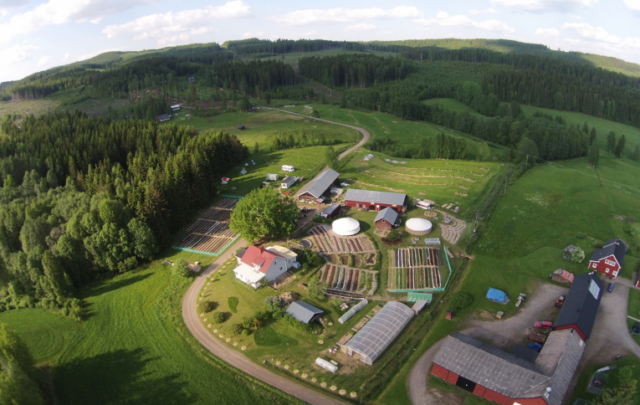Click on the headline (link) for the full text.
Many more articles are available through the Energy Bulletin homepage
Solutions and Sustainability
Voters prefer wind farms to new nuclear reactors
Angela Jameson, Times Online
THE public is sceptical about the case for building new nuclear power stations, despite concerns that Britain may have to rely on imported gas for future energy needs.
Hostility to nuclear power is matched by a belief that renewable sources of energy such as wind farms could fill the gap in energy needs in the next 20 years, the Populus survey finds.
It also indicates that politicians are not trusted to tell the truth about nuclear safety.
The poll found that 59 per cent of those questioned believe that it would be irresponsible to build more nuclear power stations while problems remain in disposing of nuclear waste. The poll found that 59 per cent of those questioned believe that it would be irresponsible to build more nuclear power stations while problems remain in disposing of nuclear waste. Half of respondents go so far as to say that they believe nuclear power to be unsafe.
(8 August 2005)
Solar Power is Hot — Too Hot
Betsey Bruner, The Arizona Daily Sun
You can look but you can’t buy. That was the word Friday from the solar energy corner of the Southwest Sustainability Expo at NAU. A worldwide shortage of solar panels has put most local projects on hold. “I get them in and they are sold before I get them in the warehouse,” said Ursula Garrett, owner of ETA Engineering in Tempe. “We’re back-ordered. The demand increased and the silicon suppliers aren’t keeping up.” …
But at the company’s booth in the NAU Fieldhouse, electrician David Lauzon said supplies were tight and the price was going up. “They’re shipping them to Germany,” Lauzon said. “Germany’s just going real big on solar. I hear they make four times what they make if they sell them over there.”
A 120-watt Kyocera photovoltaic module (solar panel) from Japan that was about $400 several years ago now sells on sale for about $550, if you can find one, he added. Other reasons for the backlog of orders include the recent passage in California and other states of generous tax credits for solar energy installation by homeowners.
Wind turbines, however, are not as scarce. “Compared to solar, wind per watt is cheaper than solar, but, of course, you have to have wind and you have to get it above the pines,” said John Ervin, another Wind & Sun salesman.
(9 August 2005)
Sustainable communities
Canadian municipalities have a great chance to de-centralize services
Dan Crawford, The Republic
Take a critical look at any town or city across Canada and examine how its basic needs are met. Electricity is transported by wire hundreds of miles, natural gas is piped even longer distances, and water comes normally from only one source.
Our infrastructure is very much based on a centralized model. This is a model that cannot easily be made efficient. …
As an individual it is important to be involved at the community level in helping to facilitate this change in how your basic needs are being met. One of the easiest and most effective ways to do this is by notifying your local municipality of the funding opportunities available from a body of the Canadian Government called the Federation of Canadian Municipalities. …
(4 August 2005)
If ENN Readers Could Have Written the Energy Bill…
Staff, Environmental News Network
Last week ENN publisher Jerry Kay challenged readers to come up with their own vision for the nation’s energy bill. Jerry wrote, “If you could have written our national energy legislation what would you have included?” Here are the most recent responses….
(9 August 2005)
N.J. farms’ latest crop: Solar power
Linda A. Johnson, Associated Press
Move over, Jersey tomatoes. Some farmers are producing a new crop: energy.
They’re putting solar power systems over barn roofs and fields to make
electricity for their homes, farm buildings and irrigation systems – and
reducing pollution at the same time.
A further lure is a unique program that uses state rebates, credits and investor
funds to cover all the upfront costs of the expensive solar power systems,
including maintenance. The program also guarantees farmers at least 10 percent
savings on their electric bills.
(8 August 2005)
Brasil launches new bio-energy program
Staff, RadioBrasil translated by Allen Bennett
Brasília – Today minister of Agriculture, Roberto Rodrigues, will be in São Luiz for the launch of Maranhão’s Bio-Energy Program. The program will provide farmers around the country, but especially in the Northeast and Central-West, with incentives to cultivate sugarcane so it can be used for sugar, alcohol and biofuel.
“We hope to attract farmers who own low-qualtity land,” explained Jose Reinaldo, the governor of Maranhão. The program goal is to build 20 new sugar-alcohol mills over a five-year period, which would mean a 15% rise in production nationwide. …
(8 August 2005)
Sugar on uncharted course, link to funds, energy
David Brough, Reuters via SignonSanDiego
LONDON – Sugar prices, the highest for nearly five years, are entering uncharted territory as investment funds show a record interest in the commodity which traders see as increasingly tied to energy markets. After raw sugar futures set a fresh 4-1/2 year high of 10.35 cents per lb last week, some traders say they have the potential to break through the 11 cents per lb barrier this year.
For the month of October, New York Board of Trade (NYBOT) (SBV5) raw sugar futures prices, which have jumped 11.5 percent so far this year, closed on Friday at 10.08 cents per lb. “The world market is approaching uncharted, choppy waters,” said Sergey Gudoshnikov, senior economist of the London-based International Sugar Organization (ISO).
He referred to unprecedented interest by investment funds in sugar, and a heightened focus on sugar-based ethanol, a biofuel, as a consequence of all-time high crude oil prices, which on Monday hit a fresh record of $62.89 a barrel. “A lot of funds consider sugar to be an energy product, instead of an agricultural product,” he said. …
(8 August 2005)
The Spud of Life
John Vivian, Mother Earth News
…You can expect to harvest one to three pounds of spuds per foot of
two-and-a-half- to three-foot-wide row. At 20 calories per live ounce, and 16
ounces to the pound, that’s an average of 600 calories per row-foot. If
potatoes provide your entire calorie intake, a 2,400 calorie per day or better
subsistence diet will require only four row-feet per day of potatoes: 4 x 365
days = 1,400 row-feet for a year’s calories. That’s about 60 25foot-long rows
for one, 120 rows for two.
Multiply potato land by four so you can rotate and grow green manures to
maintain fertility of the soil, then double that again for grain and
vegetables, pet, chicken, pig, and rabbit feed. Add in land for a house
and shed and you can eat well with a short acre (200 feet by 200 feet) under
cultivation, thanks to the efficiency of the humble spud. It is an area that
one adult can work entirely by hand. I know; I’ve done it. I must admit,
though, that a rotary tiller makes the work go a whole lot faster and easier.
(1999)
Not just a grower’s guide, but a fascinating history of one of our most
useful high energy producing crops.
Environment
Malaysia Bans Open Burning around Kuala Lumpur and Central Selangor State as Haze Worsens
Staff, Associated Press
KUALA LUMPUR, Malaysia — Malaysia has banned most forms of open burning, including camp fires and outdoor cooking, in a desperate measure to ease the stifling haze blanketing Kuala Lumpur and surrounding areas due to smoke from forest fires in neighboring Indonesia.
The Meteorological Department repeated a low visibility warning Tuesday to vessels plying the Malacca Strait, a busy shipping lane that separates peninsular Malaysia and Indonesia’s Sumatra island.
“The situation is hazardous to ships without navigational equipment,” the department said in a statement, which was an update to a similar warning issued Monday. Visibility was around 1 kilometer (about half a mile) over the central and southern area of the channel, it said.
The Natural Resources and Environment Ministry said in a statement received Tuesday that the air in seven areas including the capital Putrajaya and the country’s largest city Kuala Lumpur has become unhealthy from the haze.
The dirty white acrid haze has hung over the Klang Valley which comprises Kuala Lumpur for the past one week, reducing visibility to as low as 1 kilometer (a half mile) and making it unhealthy to walk outdoors.
Doctors have reported a rise in the number of patients suffering from sore throats and nasal congestion, the New Straits Times reported Tuesday. …
(9 August 2005)
A ‘Gulley of Death’ That Gobbles Up All On Its Way
John Oywa, AllAfrica.com
Scientists describe it as an environmental catastrophe, while villagers call it the valley of death. Shaped like a crater lake, the Katuk-Odeyo Gulley is as awful as it is intimidating.
At first, frightened elders thought it was a curse. They watched helplessly as it swallowed their farms, livestock, homes and even graves. Twenty meters deep, 15 meters wide and stretching 25 kilometres, the Katuk-Odeyo Gulley in Nyakach, Nyando District is reputed as among the deepest and most devastating in eastern Africa. …
Many farmers in the area have given up farming altogether, since the top soil has been washed off their farms and swept several kilometres into the lake. …
Mzee Jairo Onyango said his three bulls fell into the gulley and died while grazing, while his neighbour, Mr Jackton Otieno, has lost several goats and sheep. “We are scared because the gulley is extending towards our homes. Some of us have to escort our children to school for fear they may fall into the gulley,” said Mr Otieno. …
The situation has been aggravated by poverty that has made the peasant farmers turn to charcoal burning for survival. Almost every available tree has been turned into charcoal, leaving the ground bare. Kericho Highlands, too has not been spared, and charcoal burning has led to massive soil erosion. …
At a cost of $12 (Sh900) per ton, this soil is estimated to be worth $ 42.7 million (Sh3.2 billion), according to a recent Icraf bulletin.
ICRAF [International Centre for Research in Agroforestry] scientists further estimate that through erosion, Kenya loses soil whose value is three to four times higher than the annual revenue from tourism. …
(10 August 2005)
Grim, well written article detailing the successively worse impacts of poverty and over-extraction of environmental capital. Should be required reading for anyone who still thinks the environment is some subsection of the economy.-LJ
Roundup Is Killing Off Amphibians, Ecologist Says
Eric Hand, St. Louis Post-Dispatch (US)
Worldwide, amphibians are dying. And University of Pittsburgh ecologist Rick Relyea said he knows one way to kill them: Spray them with a little Roundup, the best-selling weed killer from St. Louis-based Monsanto.
In a new study from Relyea, published in this month’s issue of the journal Ecological Applications, Roundup killed 98 percent of tadpoles during a three-week test in simulated shallow ponds. In a separate dry experiment, Roundup killed 79 percent of young frogs and toads after just one day. “It’s much deadlier than we thought,” Relyea said.
Monsanto says that Roundup isn’t meant to be used near water and that its directions clearly say so. But many amphibians live in shallow puddles, Relyea said. He said he worries that wetlands within fields and forests are accidentally being sprayed.
Something clearly is killing amphibians. They have declined drastically since the 1970s, biologists say. Nearly a third of the world’s amphibians are threatened, according to a global survey last year by the International Union for the Conservation of Nature and Natural Resources. …
Roundup is a product name for a herbicide, one of many in a general class that use the chemical glyphosate, which Monsanto pioneered. Glyphosate is now the top agricultural pesticide in the U.S., according to the Environmental Protection Agency.
In 1993, the EPA renewed its permit for Roundup. It noted that glyphosate itself is not toxic to aquatic life. The problem was with one of its common surfactants, which is toxic. A surfactant is a soapy additive used so glyphosate can stick to and penetrate plants.
In Australia and Europe, Monsanto sells Roundup Biactive, a version with a different surfactant that doesn’t harm amphibians.
“Why don’t we have the other surfactant?” Relyea asked. “Either it’s less effective at killing weeds or it’s more expensive to make.”
Monsanto toxicologist Donna Farmer said the surfactant in Roundup Biactive was less effective on North American weeds and also would be subject to a cumbersome EPA approval process.
(10 August 2005)





